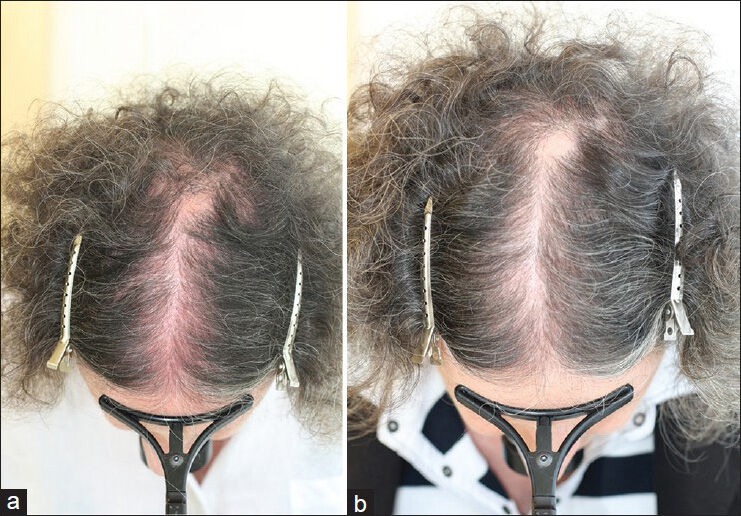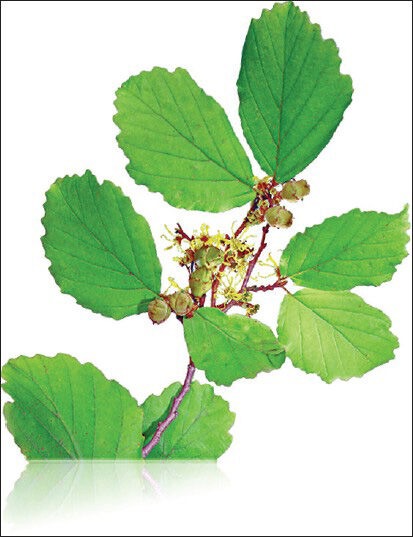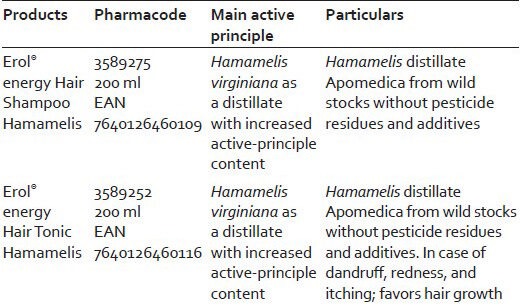Abstract
Background:
A sensitive scalp is a frequent problem in daily clinical practice and often represents a major challenge for dermatologists.
Objective:
The objective was to evaluate the efficacy of a Northamerican Virginian Witch Hazel (Hamamelis virginiana)-based shampoo and tonic (Erol® Energy) for treatment of the sensitive scalp.
Methods:
Retrospective observational study of male and female patients given Erol® Energy products in the period between August 2010 and December 2013 at the Center for Dermatology and Hair Diseases Professor Trüeb to treat irritable scalp conditions or as concomitant treatment to minoxidil therapy for androgenetic alocepia.
Results:
Shampoo was applied successfully in 1,373 patients (1,233 women and 140 men). Patients reported improvement of subjective manifestations of irritation and rated tolerance of both products as good to excellent. During this period, 369 (26.9%) have received Erol® shampoo more than once.
Conclusions:
The choice of appropriate hair-care products represents an important aspect in the management of the sensitive scalp and related conditions. With the Erol® Energy hair-care products, the advantages of H. virginiana are available for successful treatment of the scalp, especially in the context of problems associated with red scalp, scalp burn-out, and the use of topical minoxidil for androgenetic alopecia.
Keywords: North American Virginian witch hazel (Hamemelis virginiana), red scalp, scalp burn-out, sensitive scalp
INTRODUCTION
A sensitive scalp is a frequent problem in daily clinical practice and often represents a major challenge for dermatologists. In particular, patients with hair loss or alopecia frequently also complain of scalp problems that must be taken into account for a successful treatment program. The main complaint of these patients relates to a sensitive scalp, for which various causes are taken into consideration: Atopic disposition with tendency to sebostasis, irritation, and dermatitis; type IV hypersensitivity to particular shampoo ingredients, such as cocamidopropyl betaine or preservatives; age-related dryness of the skin (senile sebostasis); irritation from cosmetic hair treatments, such as changes of hair color or form; and finally, some specific dermatological scalp conditions, such as seborrheic dermatitis, psoriasis, and their treatment sequels, especially those due to the prolonged use of topical corticosteroids.
RED SCALP AND SCALP BURN-OUT
Red scalp, red scalp syndrome, and diffuse red scalp disease are terms used synonymously for a condition, characterized by: Persistent redness of the scalp, not explained by a specific dermatologic disease of the scalp, with or without sensation of itching or burning, refractory to topical corticosteroids and antiseborrheic agents, with aggravation in the sun, and the dermoscopic finding of teleangiectasia of the scalp [Figure 1a and b]. In some cases, symptoms of scalp sensitivity, itching, burning, and tension, are due to the drying out and irritating effect of alcohol-based topicals, and the propylene glycol contained as a solvent in these preparations. In others, the condition evolves in the vertex area, where the scalp is maximally exposed to ultraviolet radiation (UVR) and is the considered as a chronic UVR-related condition with analogies to rosacea.[1] At the same time, there is increasing evidence that UVR exposure also exerts a negative effect on hair growth and alopecia,[2] presumably by generating reactive oxygen species while hair papilla fibroblasts of the balding scalp have been shown to have an increased sensitivity of to oxidative stress.[3]
Figure 1.

(a and b) Red scalp syndrome, before and after 6 months treatment with a Hamamelis-containing shampoo (Erol® Energy shampoo)
Finally, scalp burn-out has been a term most recently coined for the condition of scalp sensitivity that seems not to tolerate any external stimuli anymore. In general, the burn-out syndrome is defined as a condition of emotional exhaustion with reduced capacity that is understood to represent a development line starting with enthusiastic idealism and leading through frustrating experiences to disillusionment, psychosomatic disorders, depression, and aggression. Just as the syndrome is not recognized to represent a true medical condition by the scientific community, but is rather defined as a coping problem in ICD-10,[4] individuals are encountered in daily clinical practice with an analogous patient's career about the condition of their scalp, which represents rather a question of problem-solving than a specific dermatologic condition.
Management of these conditions begins with protection of the scalp from further noxious environmental, medical, or cosmetic exposures, and acting toward its appeasement and restoration, while regaining the confidence of the patient.
The first step consists in adapting the frequency of hair-washing to the condition of the scalp and hair. Persons with greasy hair (seborrhea) should shampoo their hair often, sometimes even daily, whereas persons with dry hair (sebostasis) less often.
A mild shampoo must be selected, avoiding ingredients with high irritation potential, or containing frequent contact allergens, such as cocamidopropyl betaine and parabens.
Of particular interest are herbal special care ingredients with an anti-irritant activity from traditional phytomedicine, such as chamomile (Marticaria chamomilla), heart seed (Cardiospermum halicacabum), peony (Paeonia lactiflora), and the virginian witch hazel (Hamamelis virginiana).
NOTHAMERICAN VIRGINIAN WITCH HAZEL (HAMAMELIS VIRIGINIANA)
When Europeans originally encountered Native Americans, the American Indian tribes dwelling in the Northeastern regions utilized about 275 plants for medicinal purposes. The native Northamerican Virginian witch hazel H. virginiana [Figure 2] was among the most important of those plants and was used for treatment of superficial skin wounds and inflammatory skin conditions. The Native Americans produced witch hazel extract by boiling the stems of the shrub and producing a decoction, which was used to treat inflammatory conditions. Early Puritan settlers in New England adopted this remedy from the natives. A missionary, Dr. Charles Hawes, eventually learned of the preparation's therapeutic properties and further determined that the product of the plant's twigs was even more efficacious. Hawes’ process was further refined by Tomas Newton Dickinson, Sr., who is credited with starting the commercial production of witch hazel extract in 1866 and establishing its wide use. From the middle of the 19th century onwards, Hamamelis finally became a constituent of the official American and European medicine. The leaves (Hamamelidis folium) as well as the bark (Hamamelidis cortex) of the plant are used. The main constituents of the extract include: Tannin, gallic acid, catechins, proanthocyanins, flavonoids (kaempferol, quercetin), essential oils (carvacrol, eugenol, hexenol), choline, and saponins. It is a strong anti-oxidant and astringent, which makes it useful as a natural remedy also for acne, psoriasis, eczema, aftershave applications, ingrown nails, cracked or blistered skin, and for treating insect bites.
Figure 2.

Hamamelis twig (usable parts of the plant: Bark and leaves)
Quality plays an important role. Commonly used Hamamelis distillate (HMM-Water) elicits only low peaks for the active-principles. To achieve a rapid regeneration of the scalp and a positive course of the entire therapeutic process, the use of high-grade active principles from Hamamelis obtained from wild stocks and sustainable production, is, therefore, essential.
Today, the following commercially used medicinal preparations are obtained from Hamamelis, with the corresponding ingredients and applications, as listed in the table:[5]
Erol® Energy hair care products,(Apomedica, Switzerland), based on Virginian witch hazel, with the botanical name H. virginiana, have been specially developed for the care and treatment of the sensitive scalp. The shampoo is composed of extracts of H. virginiana and a shampoo base of mild tensidic character, free of cocamidopropyl betaine and parabens.
CLINICAL OBSERVATION
Originally, an observational study was carried out at the Department of Dermatology, University Hospital of Zurich, over a period of 6 months, from October 2009 to March 2010, during which the Hamamelis - products Erol® Energy Shampoo and Tonic were dispensed to patients complaining of scalp irritation, with or without clinical signs of inflammation. Many patients had previously used various medicinal shampoos, mainly against seborrhea and dandruff, as well as topical corticosteroids without success. After a period of application of 4 weeks, the majority of patients reported an improvement of subjective manifestations of irritation, and rated the tolerance of both products as good to excellent. Overall, the majority of the patients were satisfied with the products.
The documented efficacy can be attributed chiefly to H. virginiana. The main active principles are the flavonoids and tannins, as a natural source of antioxidants.[6] Furthermore, the additional herbals contained in Erol® Energy Hair Tonic promote skin metabolism and blood flow (rosemary, field horsetail), act inhibitory on the proliferation of propionibacterium (rosemary), have anti-dandruff activity (rosemary), strengthen the connective tissue (field horsetail), and stimulate healthy hair growth (birch, stinging nettle).
Since then, in the period between August 2010 and December 2013, Erol® Energy Shampoo has been applied successfully in 1,373 patients (1,233 women and 140 men) at the Center for Dermatology and Hair Diseases Professor Trüeb to treat irritable scalp conditions or as concomitant treatment to minoxidil therapy for androgenetic alocepia. During this period, 369 (26.9%) have received Erol® shampoo more than once. Experience shows that 2% and 5% topical minoxidil in an alcohol base for treatment of androgenetic often leads to irritation of the scalp, which can have a negative impact on the patience compliance. The complaints of patients and the redness of the scalp are often misinterpreted as seborrheic dermatitis and treated with anti-dandruff shampoos and alcohol-based topical corticosteroids (scalp applications), that only aggravate the problem through additional irritation. In shampoo form, witch hazel is particularly useful in the treatment of the red scalp syndrome and in preventing or soothing scalp irritation resulting from sustained use of ethanolic topical minoxidil solutions. An alternative is to compound minoxidil into a topical solution of H. distillate.
CONCLUSION
The choice of appropriate hair-care products represents an important aspect in the management of the sensitive scalp and related conditions, such as the red scalp syndrome, and scalp burn-out. Hair washing represents the most common form of treatment of the hair and scalp. Therefore, a shampoo must accomplish more than just cleanse. It should additionally be adapted to the specific requirements of different hair types, to age, washing habits, and most importantly, it should elicit a positive effect on problematic scalp conditions. With the Erol® Energy hair-care products, the advantages of H. virginiana are available for successful treatment of the scalp, especially in the context of the problems associated with red scalp, scalp burn-out, and the use of topical minoxidil for androgenetic alopecia.


Footnotes
Source of Support: Nil
Conflict of Interest: Ralph M. Trüeb performs consultant activity for Apomedica Switzerland.
REFERENCES
- 1.Oberholzer PA, Nobbe S, Kolm I, Kerl K, Kamarachev J, Trüeb RM. Red scalp disease - A rosacea-like dermatosis of the scalp? Successful therapy with oral tetracycline. Dermatology. 2009;219:179–81. doi: 10.1159/000228319. [DOI] [PubMed] [Google Scholar]
- 2.Trüeb RM. Is androgenetic alopecia a photoaggravated dermatosis? Dermatology. 2003;207:343–8. doi: 10.1159/000074111. [DOI] [PubMed] [Google Scholar]
- 3.Bahta AW, Farjo N, Farjo B, Philpott MP. Premature senescence of balding dermal papilla cells in vitro is associated with p16(INK4a) expression. J Invest Dermatol. 2008;128:1088–94. doi: 10.1038/sj.jid.5701147. [DOI] [PubMed] [Google Scholar]
- 4.ICD-10: Z70-Z76 auf DIMDI - DIMDI - ICD-10-GM Version. [Last accessed on 2014 Jun 12]. Available from: www.dimdi.de/static/de/klassi/icd-10-gm/kodesuche/onlinefassungen/htmlgm2013/block-z70-z76.htm .
- 5.Pschyrembel W. 3rd ed. Berlin: De Gruyter; 2006. Pschyrembel Naturheilkunde Und Alternative Heilverfahren. [Google Scholar]
- 6.Reuter J, Wölfle U, Korting HC, Schempp C. Which plant for which skin disease? Part 2: Dermatophytes, chronic venous insufficiency, photoprotection, actinic keratoses, vitiligo, hair loss, cosmetic indications. J Dtsch Dermatol Ges. 2010;8:866–73. doi: 10.1111/j.1610-0387.2010.07472.x. [DOI] [PubMed] [Google Scholar]


